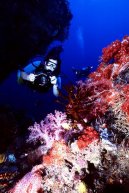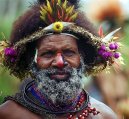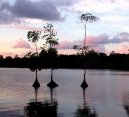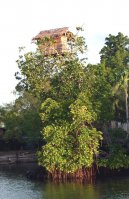| Introduction - Papua New Guinea: |
Country | Papua New Guinea |
|
Background | The eastern half of the island of New Guinea - second largest in the world - was divided between Germany (north) and the UK (south) in 1885. The latter area was transferred to Australia in 1902, which occupied the northern portion during World War I and continued to administer the combined areas until independence in 1975. A nine-year secessionist revolt on the island of Bougainville ended in 1997 after claiming some 20,000 lives. |
|
|
|
| Location - Papua New Guinea: |
Location | Oceania, group of islands including the eastern half of the island of New Guinea between the Coral Sea and the South Pacific Ocean, east of Indonesia |
|
Geographic coordinates | 6 00 S, 147 00 E |
|
Map references | Oceania |
|
Area | total: 462,840 sq km
land: 452,860 sq km
water: 9,980 sq km |
|
Area comparative | slightly larger than California |
|
Land boundaries | total: 820 km
border countries: Indonesia 820 km |
|
Coastline | 5,152 km |
|
Maritime claims | measured from claimed archipelagic baselines
territorial sea: 12 nm
continental shelf: 200-m depth or to the depth of exploitation
exclusive fishing zone: 200 nm |
|
Climate | tropical; northwest monsoon (December to March), southeast monsoon (May to October); slight seasonal temperature variation |
|
Terrain | mostly mountains with coastal lowlands and rolling foothills |
|
Elevation extremes | lowest point: Pacific Ocean 0 m
highest point: Mount Wilhelm 4,509 m |
|
Natural resources | gold, copper, silver, natural gas, timber, oil, fisheries |
|
Land use | arable land: 0.49%
permanent crops: 1.4%
other: 98.11% (2005) |
|
Irrigated land | NA |
|
Natural hazards | active volcanism; situated along the Pacific Ring of Fire; the country is subject to frequent and sometimes severe earthquakes; mud slides; tsunamis |
|
Environment current issues | rain forest subject to deforestation as a result of growing commercial demand for tropical timber; pollution from mining projects; severe drought |
|
Environment international agreements | party to: Antarctic Treaty, Biodiversity, Climate Change, Climate Change-Kyoto Protocol, Desertification, Endangered Species, Environmental Modification, Hazardous Wastes, Law of the Sea, Marine Dumping, Ozone Layer Protection, Ship Pollution, Tropical Timber 83, Tropical Timber 94, Wetlands
signed, but not ratified: none of the selected agreements |
|
Geography note | shares island of New Guinea with Indonesia; one of worlds largest swamps along southwest coast |
|
| People - Papua New Guinea: |
Population | 5,795,887 (July 2007 est.) |
|
Age structure | 0-14 years: 37.6% (male 1,107,568/female 1,070,594)
15-64 years: 58.5% (male 1,745,385/female 1,643,830)
65 years and over: 3.9% (male 106,487/female 122,023) (2007 est.) |
|
Median age | total: 21.4 years
male: 21.5 years
female: 21.2 years (2007 est.) |
|
Population growth rate | 2.163% (2007 est.) |
|
Birth rate | 28.76 births/1,000 population (2007 est.) |
|
Death rate | 7.14 deaths/1,000 population (2007 est.) |
|
Net migration rate | 0 migrant(s)/1,000 population (2007 est.) |
|
Sex ratio | at birth: 1.05 male(s)/female
under 15 years: 1.035 male(s)/female
15-64 years: 1.062 male(s)/female
65 years and over: 0.873 male(s)/female
total population: 1.043 male(s)/female (2007 est.) |
|
Infant mortality rate | total: 48.46 deaths/1,000 live births
male: 52.52 deaths/1,000 live births
female: 44.2 deaths/1,000 live births (2007 est.) |
|
Life expectancy at birth | total population: 65.62 years
male: 63.41 years
female: 67.95 years (2007 est.) |
|
Total fertility rate | 3.79 children born/woman (2007 est.) |
|
Hiv aids adult prevalence rate | 0.6% (2003 est.) |
|
Hiv aids people living with hiv aids | 60,000 (2005 est.) |
|
Hiv aids deaths | 600 (2003 est.) |
|
Nationality | noun: Papua New Guinean(s)
adjective: Papua New Guinean |
|
Major infectious diseases | degree of risk: very high
food or waterborne diseases: bacterial and protozoal diarrhea, hepatitis A, and typhoid fever
vectorborne diseases: dengue fever and malaria are high risks in some locations (2007) |
|
Ethnic groups | Melanesian, Papuan, Negrito, Micronesian, Polynesian |
|
Religions | Roman Catholic 22%, Lutheran 16%, Presbyterian/Methodist/London Missionary Society 8%, Anglican 5%, Evangelical Alliance 4%, Seventh-Day Adventist 1%, other Protestant 10%, indigenous beliefs 34% |
|
Languages | Melanesian Pidgin serves as the lingua franca, English spoken by 1%-2%, Motu spoken in Papua region
note: 820 indigenous languages spoken (over one-tenth of the worlds total) |
|
Literacy | definition: age 15 and over can read and write
total population: 57.3%
male: 63.4%
female: 50.9% (2000 census) |
|
| Government - Papua New Guinea: |
Country name | conventional long form: Independent State of Papua New Guinea
conventional short form: Papua New Guinea
local short form: Papuaniugini
former: Territory of Papua and New Guinea
abbreviation: PNG |
|
Government type | constitutional parliamentary democracy |
|
Capital | name: Port Moresby
geographic coordinates: 9 30 S, 147 10 E
time difference: UTC+10 (15 hours ahead of Washington, DC during Standard Time) |
|
Administrative divisions | 20 provinces; Bougainville, Central, Chimbu, Eastern Highlands, East New Britain, East Sepik, Enga, Gulf, Madang, Manus, Milne Bay, Morobe, National Capital, New Ireland, Northern, Sandaun, Southern Highlands, Western, Western Highlands, West New Britain |
|
Independence | 16 September 1975 (from the Australian-administered UN trusteeship) |
|
National holiday | Independence Day, 16 September (1975) |
|
Constitution | 16 September 1975 |
|
Legal system | based on English common law; has not accepted compulsory ICJ jurisdiction |
|
Suffrage | 18 years of age; universal |
|
Executive branch | chief of state: Queen ELIZABETH II (since 6 February 1952); represented by governor general Sir Paulius MATANE (since 29 June 2004)
head of government: Prime Minister Sir Michael SOMARE (since 2 August 2002); Deputy Prime Minister Puka TEMU (since 29 August 2007)
cabinet: National Executive Council appointed by governor general on recommendation of prime minister
elections: none; monarch is hereditary; governor general nominated by parliament and appointed by chief of state; following legislative elections, leader of majority party or leader of majority coalition usually is appointed prime minister by governor general |
|
Legislative branch | unicameral National Parliament (109 seats, 89 filled from open electorates and 20 from provinces and national capital distict; members elected by popular vote to serve five-year terms); constitution allows up to 126 seats
elections: last held from 30 June to 10 July 2007; next to be held in June 2012
election results: percent of vote by party - NA; seats by party - National Alliance 27, PNGP 8, PAP 6, URP 6, PANGU 5, PDM 5, independents 19, others 33; note - election to 1 seat was nullified
note: 15 other parties won 4 or fewer seats; association with political parties is fluid |
|
Judicial branch | Supreme Court (the chief justice is appointed by the governor general on the proposal of the National Executive Council after consultation with the minister responsible for justice; other judges are appointed by the Judicial and Legal Services Commission) |
|
Political parties and leaders | National Alliance Party or NA [Michael SOMARE]; Papua and Niugini Union Party or PANGU [Andrew KUMBAKOR]; Papua New Guinea Party or PNGP [Sir Mekere MORAUTA]; Peoples Democratic Movement or PDM [Michael OGIO]; Peoples Action Party or PAP [Gabriel KAPRIS]; United Resources Party or URP [William DUMA] (2007) |
|
Political pressure groups and leaders | NA |
|
International organization participation | ACP, APEC, ARF, AsDB, ASEAN (observer), C, CP, FAO, G-77, IBRD, ICAO, ICRM, IDA, IFAD, IFC, IFRCS, IHO, ILO, IMF, IMO, Interpol, IOC, IOM (observer), IPU, ISO (correspondent), ITSO, ITU, MIGA, NAM, OPCW, PIF, Sparteca, SPC, UN, UNCTAD, UNESCO, UNIDO, UNWTO, UPU, WCO, WFTU, WHO, WIPO, WMO, WTO |
|
Diplomatic representation in the us | chief of mission: Ambassador Evan Jeremy PAKI
chancery: 1779 Massachusetts Avenue NW, Suite 805, Washington, DC 20036
telephone: [1] (202) 745-3680
FAX: [1] (202) 745-3679 |
|
Diplomatic representation from the us | chief of mission: Ambassador Leslie V. ROWE
embassy: Douglas Street, Port Moresby, N.C.D.
mailing address: 4240 Port Moresby PI, US Department of State, Washington DC 20521-4240
telephone: [675] 321-1455
FAX: [675] 321-3423 |
|
Flag description | divided diagonally from upper hoist-side corner; the upper triangle is red with a soaring yellow bird of paradise centered; the lower triangle is black with five, white, five-pointed stars of the Southern Cross constellation centered |
|
| Economy - Papua New Guinea: |
Economy overview | Papua New Guinea is richly endowed with natural resources, but exploitation has been hampered by rugged terrain and the high cost of developing infrastructure. Agriculture provides a subsistence livelihood for 85% of the population. Mineral deposits, including oil, copper, and gold, account for nearly two-thirds of export earnings. The government of Prime Minister SOMARE has expended much of its energy remaining in power and should be the first government in decades to serve a full five-year term. The government also brought stability to the national budget, largely through expenditure control; however, it has relaxed spending constraints in 2006 and 2007 as elections approach. Numerous challenges still face the government including regaining investor confidence, restoring integrity to state institutions, promoting economic efficiency by privatizing moribund state institutions, and balancing relations with Australia, its former colonial ruler. Other socio-cultural challenges could upend the economy including a worsening HIV/Aids epidemic and chronic law and order and land tenure issues. Australia annually supplies $240 million in aid, which accounts for nearly 20% of the national budget. |
|
Gdp purchasing power parity | $15.41 billion (2006 est.) |
|
Gdp official exchange rate | $4.167 billion (2006 est.) |
|
Gdp real growth rate | 3.7% (2006 est.) |
|
Gdp per capita ppp | $2,700 (2006 est.) |
|
Gdp composition by sector | agriculture: 35.7%
industry: 37.1%
services: 27.2% (2006 est.) |
|
Labor force | 3.477 million (2006 est.) |
|
Labor force by occupation | agriculture: 85%
industry: NA%
services: NA% |
|
Unemployment rate | 2% up to 80% in urban areas (2004) |
|
Population below poverty line | 37% (2002 est.) |
|
Household income or consumption by percentage share | lowest 10%: 1.7%
highest 10%: 40.5% (1996) |
|
Distribution of family income gini index | 50.9 (1996) |
|
Inflation rate consumer prices | 2.5% (2006 est.) |
|
Investment gross fixed | 19.2% of GDP (2006 est.) |
|
Budget | revenues: $2.155 billion
expenditures: $2.166 billion; including capital expenditures of $344 million (2006 est.) |
|
Public debt | 53.7% of GDP (2006 est.) |
|
Agriculture products | coffee, cocoa, copra, palm kernels, tea, sugar, rubber, sweet potatoes, fruit, vegetables, vanilla; shell fish, poultry, pork |
|
Industries | copra crushing, palm oil processing, plywood production, wood chip production; mining of gold, silver, and copper; crude oil production, petroleum refining; construction, tourism |
|
Industrial production growth rate | NA% |
|
Electricity production | 3.358 billion kWh (2004) |
|
Electricity consumption | 3.123 billion kWh (2004) |
|
Electricity exports | 0 kWh (2004) |
|
Electricity imports | 0 kWh (2004) |
|
Oil production | 50,000 bbl/day (January 2006 est.) |
|
Oil consumption | 18,000 bbl/day (January 2006 est.) |
|
Oil exports | NA bbl/day |
|
Oil imports | NA bbl/day |
|
Oil proved reserves | 240 million bbl (1 January 2005 est.) |
|
Natural gas production | 140 million cu m (2004 est.) |
|
Natural gas consumption | 140 million cu m (2004 est.) |
|
Natural gas exports | 0 cu m (2004 est.) |
|
Natural gas imports | 0 cu m (2004 est.) |
|
Natural gas proved reserves | 345.5 billion cu m (1 January 2005 est.) |
|
Current account balance | $661 million (2006 est.) |
|
Exports | $4.096 billion f.o.b. (2006 est.) |
|
Exports commodities | oil, gold, copper ore, logs, palm oil, coffee, cocoa, crayfish, prawns |
|
Exports partners | Australia 30.3%, Japan 8.2%, China 5.7% (2006) |
|
Imports | $1.686 billion f.o.b. (2006 est.) |
|
Imports commodities | machinery and transport equipment, manufactured goods, food, fuels, chemicals |
|
Imports partners | Australia 53%, Singapore 12.8%, China 6%, Japan 4.4% (2006) |
|
Reserves of foreign exchange and gold | $1.099 billion (2006 est.) |
|
Debt external | $1.801 billion (2006 est.) |
|
Economic aid recipient | $NA |
|
Currency code | kina (PGK) |
|
Exchange rates | kina per US dollar - 3.0643 (2006), 3.08 (2005), 3.2225 (2004), 3.5635 (2003), 3.8952 (2002) |
|
| Communications - Papua New Guinea: |
Fiscal year | calendar year |
|
Telephones main lines in use | 63,700 (2005) |
|
Telephones mobile cellular | 75,000 (2005) |
|
Telephone system | general assessment: services are adequate; facilities provide radiotelephone and telegraph, coastal radio, aeronautical radio, and international radio communication services
domestic: mostly radiotelephone
international: country code - 675; submarine cables to Australia and Guam; satellite earth station - 1 Intelsat (Pacific Ocean); international radio communication service |
|
Radio broadcast stations | AM 8, FM 19, shortwave 28 (1998) |
|
Television broadcast stations | 3 (all in the Port Moresby area; stations at Mt. Hagen, Goroka, Lae, and Rabaul are planned) (2004) |
|
Internet country code | .pg |
|
Internet hosts | 1,573 (2006) |
|
Internet users | 110,000 (2006) |
|
| Transportation - Papua New Guinea: |
Airports | 582 (2006) |
|
Airports with paved runways | total: 21
2,438 to 3,047 m: 2
1,524 to 2,437 m: 14
914 to 1,523 m: 4
under 914 m: 1 (2006) |
|
Airports with unpaved runways | total: 561
1,524 to 2,437 m: 11
914 to 1,523 m: 62
under 914 m: 488 (2006) |
|
Heliports | 2 (2006) |
|
Pipelines | oil 264 km (2006) |
|
Roadways | total: 19,600 km
paved: 686 km
unpaved: 18,914 km (1999) |
|
Waterways | 11,000 km (2006) |
|
Merchant marine | total: 24 ships (1000 GRT or over) 55,532 GRT/72,240 DWT
by type: bulk carrier 2, cargo 18, passenger/cargo 2, petroleum tanker 1, roll on/roll off 1
foreign-owned: 6 (UK 6) (2006) |
|
Ports and terminals | Kimbe, Lae, Rabaul |
|
| Military - Papua New Guinea: |
Military branches | Papua New Guinea Defense Force (includes Maritime Operations Element, Air Operations Element) (2007) |
|
Military service age and obligation | 18 years of age (est.); no conscription (2001) |
|
Manpower available for military service | males age 18-49: 1,264,728
females age 18-49: 1,167,188 (2005 est.) |
|
Manpower fit for military service | males age 18-49: 902,432
females age 18-49: 894,759 (2005 est.) |
|
Refugees and internally displaced persons | refugees (country of origin): 9,991 (Indonesia) (2006) |
|
Military expenditures percent of gdp | 1.4% (2005 est.) |
|
Disputes international | relies on assistance from Australia to keep out illegal cross-border activities from primarily Indonesia, including goods smuggling, illegal narcotics trafficking, and squatters and secessionists |
|
This page was last updated on 16 September, 2007



